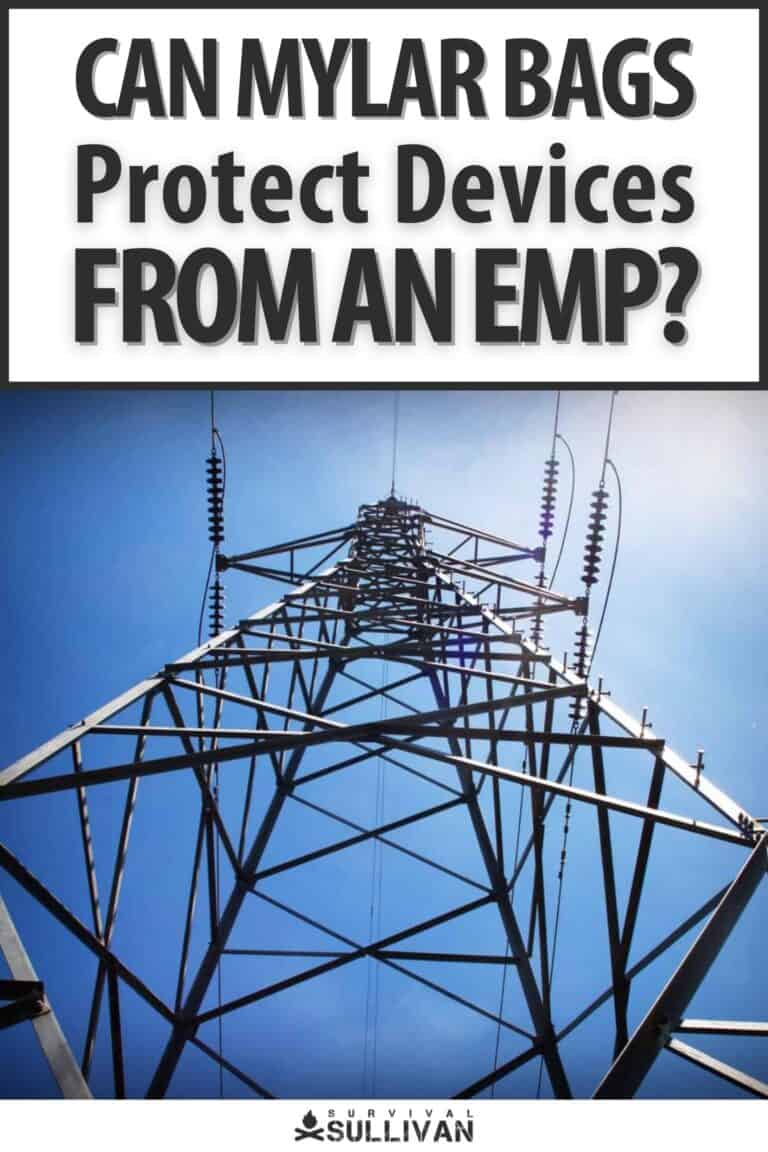An EMP, or electromagnetic pulse, is a sudden burst of electromagnetic radiation. It can be caused by a number of things, including natural events like solar flares and man-made devices like nuclear weapons.

When an EMP occurs, it can disrupt or even destroy electronic devices and power systems.
These events are thought to be one of the most likely doomsday scenarios of our time, and protecting yourself and your equipment against them is important.
To this end, some people have asserted that common mylar bags can protect electronic devices from an EMP. Can they?
No, mylar bags won’t provide significant protection against an EMP. Mylar bags are made of a material that is not particularly good at absorbing or deflecting electromagnetic radiation.
EMPs will cause widespread blackouts, communication failures, and other serious problems. The consequences of an EMP can even be deadly.
That’s why it’s important to understand what an EMP is and more importantly how to protect yourself and your equipment in the event of an EMP attack.
Sadly, mylar bags probably aren’t it. We will talk more about this challenging problem in the rest of this article.
What are Mylar Bags?
Mylar bags are made from a type of plastic called polyethylene terephthalate (PET). This material is also used to make water bottles, food packaging, and some types of clothing.
Mylar bags are often used to package food because they are good at keeping oxygen out. They are also popular for storing survival supplies because they are lightweight and easy to store.
Some mylar bags are lined with a skin of metal, usually aluminum, which can reflect light and heat. It is this reflective property that has led some people to believe that mylar bags might protect electronic devices from an EMP.
Can Mylar Bags Protect Against an EMP?
Mylar bags are not, however, purpose designed to protect against electromagnetic radiation, and certainly not against a powerful and energetic event like an EMP.
Even so, mylar bags are often repurposed to store electronics because they are thought to protect them from electromagnetic interference (EMI).
EMI is a type of electromagnetic radiation that can interfere with the normal functioning of electronic devices.
Mylar bags are sometimes used to ship sensitive electronic equipment because they are thought to provide some protection against low levels of static buildup.
An EMP is a much more powerful and destructive event than everyday EMI, however. An EMP can generate electrical fields thousands of times stronger than the Earth’s magnetic field.
It can also release as much energy in a few milliseconds to fry electronics several dozen times over. Mylar bags are not designed to protect against that sort of event.
Mylar Bags are Probably Not Thick Enough
The basic issue with mylar bags for this purpose is that they are not thick enough. Mylar is typically only a few mils thick, and the metallic coating far thinner than that.
That might be enough to protect against low levels of EMI, but it won’t do much against an EMP.
For comparison, a faraday cage is a device that is purpose-built to protect against EMPs. These cages are typically made of sturdy metal mesh, paneling, or thicker foil, and they need to be in order to provide adequate protection.
That’s because EMPs generate an intense electrical field, and that field has to be dispersed or absorbed over a large area of material with enough conductivity to resist the energy from basically blowing past it.
Mylar Bags Don’t Have a Reliable Metal-to-Metal Closure
Another critical design flaw in mylar bags when it comes to EMP protection is the lack of a reliable metal-to-metal closure.
A good Faraday cage will have a door or lid that seals shut with a special gasket or another form of reliable metal-to-metal electrical contact. This is important because EMPs generate a very intense magnetic field.
That field can induce currents in any nearby conducting materials if it can “leak” through, even including the metal enclosure of a Faraday cage.
Mylar bags usually have plastic zipper closures of some kind, and those are in no way adequate to totally isolate a vulnerable item inside the bag.
Even if the mylar material itself was thick enough and conductive enough to provide some measure of protection, the zipper closure would be a weak spot that could easily allow an EMP to destroy whatever is inside the bag.
Some users have asserted that a vacuum- or heat-sealed mylar bag overcomes this issue, but there has been no reliable, lab-certified testing done either way.
Even then, assuming the closure was no longer the weak point a mylar bag would still have all of its other shortcomings.
Mylar Bags Stopping Cell Phone Signals is Not Proof of EMP Shielding
Perhaps the most compelling argument for the use of mylar bags as EMP protective enclosures is the fact that they may block cell phone signals.
The “test” looks like this: put a cell phone in a mylar bag, seal the bag shut, and then try to place a call to the phone in the bag.
If the call cannot be made, it is taken as evidence that the mylar bag is somehow protecting the phone from the signal.
If mylar bags can block cell phone signals, the reasoning goes, then surely they must be able to protect against an EMP as well.
This test is not only flawed, but it’s also completely irrelevant to EMP protection. Cell phone signals are low-powered electromagnetic waves (radio waves), and they are easily blocked by any number of materials, including mylar. That has nothing whatsoever to do with EMPs, however.
An EMP is an intense burst of electromagnetic energy that can destroy electronic devices. It literally fries them.
So even if mylar bags could protect against cell phone signals (which they can’t), that would not be evidence that they could protect against an EMP.
So, in conclusion, mylar bags are not going to protect your equipment from an EMP. If you’re looking for EMP protection, you’ll need to seek out a purpose-built Faraday cage.
Invest in or Build a Proper Faraday Cage or Bag for EMP Protection
If you want to protect your equipment from an EMP, you’ll need to invest in or build a proper faraday cage or bag.
These devices are purpose-built to resist the intense electrical and magnetic fields generated by an EMP, and they’re the only things that have been shown to be effective at doing so that they’re a practical option for the average citizen.
You could purchase a readymade bag, container, or other enclosure for the purpose, or build your own.
If you go the DIY route, just be sure to use proper materials and techniques so that your cage will actually work when you need it to.
It sounds impossible to the uninitiated, but the principles behind a Faraday cage are actually quite simple to understand. With a little ingenuity and careful attention, it is possible to make one yourself.
A full discussion of DIY designs and techniques is beyond the confines of this short article, but we have many other articles to guide you here on Survival Sullivan.


Tom Marlowe practically grew up with a gun in his hand, and has held all kinds of jobs in the gun industry: range safety, sales, instruction and consulting, Tom has the experience to help civilian shooters figure out what will work best for them.
